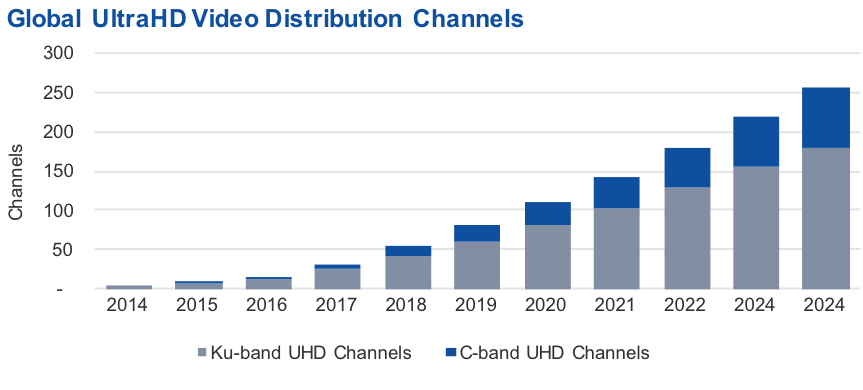UltraHD: An Ultra Growth Story
Jul 23rd, 2015 by Alan Crisp, NSR
Despite continuing concerns about OTT threatening the future
growth of Linear TV (which are for the most part unwarranted),
UltraHD, with its premium nature, is being seen as a fresh way
to grow DTH, Cable and IPTV businesses further worldwide.
While 3DTV never really took off, UltraHD investment has
risen to new highs, with seemingly every few weeks another DTH
platform announcing its UltraHD intentions, trials, or
commercial broadcast. Just last week Sky Deutschland secured
more capacity in order to commence UltraHD broadcasts, and the
Polish public broadcaster, TVP is trialling UltraHD on
terrestrial television in Warsaw. Don’t be surprised to see more
UltraHD announcements coming to a DTH platform near you.
According to NSR’s recently released Linear TV via Satellite:
DTH, OTT & IPTV, 8th Edition, the number UltraHD channels
broadcasting will accelerate longer term with growth of the new
format in every region worldwide, developing and developed.

On DTH platforms, by 2024 NSR expects UltraHD linear content
to consume approx. 70 transponders globally from 315+ UltraHD
channels. This equates to an estimated additional $185M in
leasing revenues from UltraHD content on DTH alone. This means
in 2024, UltraHD represents 1.2% of capacity globally on Ku-band
DTH – a niche market, but one which is highly sought after by
the premium market.
For video distribution to Cable and IPTV headends, a similar
trend emerges. 180 UltraHD channels on Ku-band and 75 channels
on C-band, leading to a combined total of 57 transponders,
roughly 4% of global distribution capacity on all bands
attributed to UltraHD, leading to an even larger $219M in
leasing revenues.

NSR previously noted that SD programming is the largest
driver for subscribers, revenues, and channels in developing
(high growth) regions. Whilst NSR sees SD to be the largest
growth opportunity in these regions, UltraHD plays a key
supplemental role at targeting those with increasingly higher
levels of disposable income available. This is the view that DTH
platforms in India took when they publicly announced their
UltraHD plans, with sports content now available in the format,
likewise with Tricolor TV in Russia when they are expected to
launch their UltraHD channel in the next year.
On the other hand in developed regions, where subscriber
growth remains low, and in the United States in some instances
declining, UltraHD is poised to be a way to move customers from
basic TV packages, primarily SD content, towards premium and
ultra-premium services, thus increasing ARPU and revenue growth.
KT SkyLife in Korea and Sky PerfecTV in Japan are already
broadcasting 24 hours per day a variety of content on their
linear streams. Both markets are already quite saturated with
pay TV, but they intend for UltraHD to increase revenues from
their existing subscriber bases.
UltraHD isn’t limited to the realm of Linear TV – in fact far
from it. The popularity of the format has already been
demonstrated in North America and elsewhere with the success of
the UltraHD subscriber base on Netflix, where not only is
Netflix able to charger higher monthly fees for UltraHD access,
but actually been successful in convincing customers to join
this highest tier. Higher ARPUs from UltraHD content have
already been demonstrated.
This combined with the fact that UltraHD TV sets are now
lower in price than ever before, with Sharp now selling UltraHD
TV sets for under $600, means that Linear TV will follow in the
footsteps of OTT services and start broadcasting content soon in
the new format.
Although these OTT services are cutting into viewing hours of
traditional Linear TV content, it is NSR’s view that there
remain very compelling reasons for consumers to continue
subscribing and paying for Linear content – most notably movies,
sports, and other live events. What’s notable is this is the
exact type of content that is first being filmed in UltraHD –
movies and sports. Without an UltraHD service in the
medium-term, Linear TV may appear to be a lower quality service
compared to OTT in regions that are offering UltraHD content.
Thus implementing UltraHD for sports content adds yet another
compelling reason for customers to sign-up and remain
subscribers for pay TV services. With Netflix, YouTube and other
OTT platforms already serving UltraHD content and consumer
awareness and familiarity of UltraHD rising, consumers in
developed regions will come to expect UltraHD content on their
pay TV services, sooner rather than later. No wonder satellite
operators are upping their investment for these high quality
products.
Bottom Line
UltraHD programming is expected to see strong takeup rates
globally, with fastest growth expected in North America and the
weakest in Sub-Saharan Africa. Although SD content is driving
growth in developing regions, providing UltraHD content is
important to capture the higher levels of spending that some in
these markets can afford. While the satellite capacity
requirements over the long-term are a niche market, it is an
important niche that will drive Linear TV platforms towards
higher ARPUs and revenues. The upward trend for UltraHD is
clearer than ever, and a failure to invest now will mean a
failure to tap into its growing premium revenues.